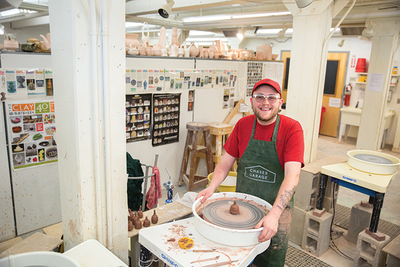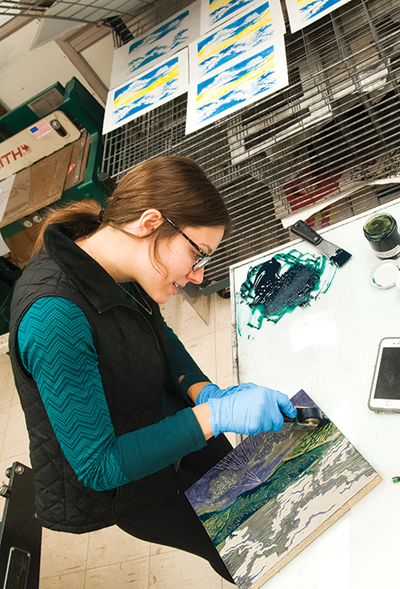STEM to STEAM

Courtesy of New Hampshire Institute of Art.
A history lesson in Elizabeth Cornell Wilkin’s classroom is likely to begin with a lump of clay. The students who twist, crush and shape it are imagining their way into the academic material, she says. “You want students to focus and begin to internalize what they’re learning, and this gives them a hands-on way to get interested.”
Such integrations of learning are the exception, but for that matter, so are regular art classes. For years, public education policy in this country has focused on STEM: Science, Technology, Engineering and Math. But that appears to be changing. In a sudden fit of bipartisan enlightenment in December of 2015, Congress encouraged STEM to evolve into STEAM, making federal funding available for the arts in public schools for the first time in more than a decade.
Still, school districts have to redesign their own curricula and specifically request the funding. Without active lobbying for the arts (which few in education are used to doing), that money’s going to stay on the table. To give educators the tools they need to persuade their districts to adopt STEAM, a new era of cooperation may be needed between schools and their arts communities. In November, educators, artists and arts advocates met in Claremont, NH, for a two-day conference, “The Arts Are Essential.”

Courtesy of New Hampshire Institute of Art.
Why are the arts “essential”? “Because they’re important to our culture,” is the straightforward answer from Matt Wilson, of MASSCreative and one of the keynote speakers. For him, the question isn’t why but how do you get there? How do we inject ourselves into the conversation politicians are having? MASSCreative’s answer is political activism. The organization mobilizes involvement from every quarter of the arts—from major museums and nonprofits to individuals on social media. They educate lawmakers about the benefits of the arts and rally public support for investing in them through the Massachusetts Cultural Council. Their efforts are paying off. In 2015, Massachusetts lawmakers increased arts and cultural funding by $1.5 million. Then-Governor Deval Patrick tripled the state’s investment, from $5 to $15 million, for maintenance of Massachusetts’ cultural venues. This year, the group averted a major budget cut that would have devastated arts funding statewide.
Those at the conference seemed more or less in agreement as to why the arts are “essential.” Julianne Gadoury, arts education coordinator for the New Hampshire State Council on the Arts, set the tone in her introductory remarks, “The arts are essential in sparking creativity, passion, drive and commitment,” she said. “The arts are essential to a well-rounded education, well-rounded communities and essential as an expression of our humanity, creativity and intellect.”
So how do you convince the decision makers? Wilson’s strategy is to craft a new narrative. MASSCreative’s stated goal “is not to build a strong arts community,” he says, “but to build a strong Massachusetts that is enriched with vibrant and thriving creative arts communities.” The difference, he said, is between asking for money and “building our downtowns, educating our children, creating livable, healthy places to live.”
In the schools, it’s largely about improving student engagement, both with teachers and the curriculum, increasing attendance, improving academic performance, upping college admission rates, and crucially, fostering “critical 21st century skills.” Wilson cited two recent studies by the Partnership for 21st Century Skills that showed roughly 75 percent of the country’s workforce managers think creativity and innovation will increase in importance over the coming years, but only 5 percent of voters rank schools a 9 out of 10 in teaching creativity and innovation.

Courtesy of New Hampshire Institute of Art.
In place of No Child Left Behind, the new mandate is the Every Student Succeeds Act (ESSA), signed by President Obama on December 10, 2015. The new legislation stresses that students should have a “well-rounded education” that includes a broad curriculum, including all domains of the arts. It’s a radical shift from focusing on “core subjects” to education of the “whole child.” Arts and music education are specified as eligible for support under “expanded learning time” provisions.
Getting attention, and money, for the arts comes down to “getting a seat at the table,” attending administrative meetings and making noise, says Cynthia Robinson, an eco-artist, arts-in-the-community advocate and director of the Karl Drerup Art Gallery at Plymouth State University. As school districts meet this year to brainstorm new measures of “accountability and assessment” to supplement standardized testing, she says, educators and artists both need “to show up at the table—all the time—and bring friends.”
The challenge is that art’s “essential” role in education and childhood development is difficult to quantify, even though art’s benefit is nearly universally recognized—recent studies are testing the correlation between higher academic achievement with arts in the classroom. Whatever the disconnect, what too often gets lost in the noise is the stunning fact that art is our best way back to our truest home and deepest mystery – that of the human heart.
“The arts help you see yourself,” says Stuart Kestenbaum, Maine poet laureate. “How does art help you to be around an issue, to integrate it and not know where you’re going to end up—because surprise leads to creativity. You always want to be in the ‘I don’t know’ place,” he says. “What if is the key to creativity…”
“We have to show up if we want to change the story,” Cynthia Robinson agreed, “to keep moving from ‘if only’ to ‘what if’ and creating the culture of possibilities.”
Christopher Volpe is a New Hampshire-based artist and teacher who has taught art history at the New Hampshire Institute of Art, Chester College of New England and Franklin Pierce University.
